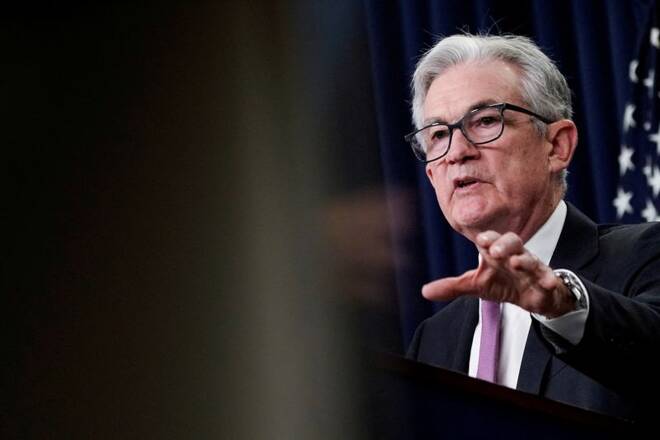Advertisement
Advertisement
Fed’s Powell’s absence of specific guidance leaves analysts to fill the gaps
By:
By Ann Saphir WASHINGTON (Reuters) - After the U.S. central bank raised its policy target interest rate on Wednesday by three-quarters of a percent for the second month in a row, Federal Reserve Chair Jerome Powell did something he hasn't done since rate hikes began in March: He avoided putting exact numbers to the size of the next rate hike.
By Ann Saphir
WASHINGTON (Reuters) – After the U.S. central bank raised its policy target interest rate on Wednesday by three-quarters of a percent for the second month in a row, Federal Reserve Chair Jerome Powell did something he hasn’t done since rate hikes began in March: He avoided putting exact numbers to the size of the next rate hike.
That didn’t stop analysts from filling in the gaps – and fill them they did, with some arguing the omission was a signal the Fed would soon pivot to a slower pace of rate hikes, and others arguing just the opposite.
What was not clear, as the vigorous debate over the Fed’s next step erupted, is who will turn out to be right.
Powell signaled that he and his 18 rate-setting colleagues don’t know either.
“While another unusually large increase could be appropriate at our next meeting, that is a decision that will depend on the data we get between now and then,” Powell said, noting that there will be two full months of data before the Fed’s next meeting, in September. That includes two employment reports, and more importantly, more key readings of an inflation situation that has put policymakers in such a pickle.
There is also a highly anticipated global central bankers meeting in late August, a forum that Powell in the past has used to lay out his latest thinking on the monetary policy outlook.
“We will continue to make our decisions meeting by meeting, and communicate our thinking as clearly as possible,” Powell said.
Powell did offer some clues. Returning inflation to the Fed’s 2% goal was something the Fed “must do,” he said, and some softening of the very strong labor market and economic growth was not only to be expected but a necessary part of bringing price pressures down.
He pointed to policymaker forecasts published at the Fed’s June meeting suggesting the policy rate would rise to 3.4% by year-end as the “best guide” on current thinking, but noted that inflation had come in higher and economic activity weaker since then.
But Powell didn’t translate his economic observations into specific guidance on how big the next Fed rate hike will be — as he had ahead of each of the Fed’s March, May, June and July meetings.
So analysts did it for him.
Noting that Powell “had a very different tone” than at prior press conferences and seem more “relaxed and balanced,” Jefferies economist Aneta Markowska said her takeaway was that Powell’s “base case” for September was likely a half-point hike.
With the policy rate in the 2.25%-2.5% range after Wednesday’s move, the Fed would need to switch to a smaller move so as not to overshoot the pace sketched out in the Fed’s June forecasts, she argued.
To Piper Sandler’s Roberto Perli, by contrast, Powell left the door “wide open” to another 75-basis-point move in September.
“Unusually large most likely means 75 bps,” Perli said. “Powell did not pivot today.”
The Fed, he said, remains “hawkish. … What Powell did was to decline to provide precise numbers as to the size of those future hikes. He did not signal that rate hikes will stop soon.”
But financial markets reacted as if Powell did, with stocks rising and futures contracts tied to the Fed’s benchmark rate pricing in a shallower path of rate hikes, and even rate cuts to start by the middle of next year.
Eric Souza, a portfolio manager at Silicon Valley Bank, heard something in between.
“Powell tried not to tip his hand” Souza said, but “I think … at this point, the September meeting I think is going to be 50 or 75 (basis points), data dependent,” with policymakers opting for the smaller hike if inflation eases more than expected and the bigger hike if it heats up.
“And after that, I think we will really see.”
(Reporting by Ann Saphir; Editing by Dan Burns and Leslie Adler)
About the Author
Reuterscontributor
Reuters, the news and media division of Thomson Reuters, is the world’s largest international multimedia news provider reaching more than one billion people every day. Reuters provides trusted business, financial, national, and international news to professionals via Thomson Reuters desktops, the world's media organizations, and directly to consumers at Reuters.com and via Reuters TV. Learn more about Thomson Reuters products:
Did you find this article useful?
Latest news and analysis
Advertisement
